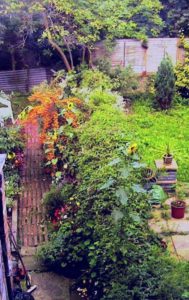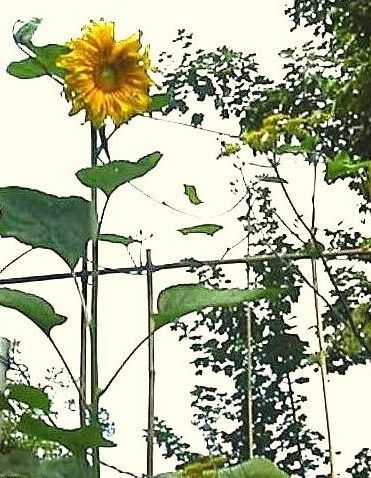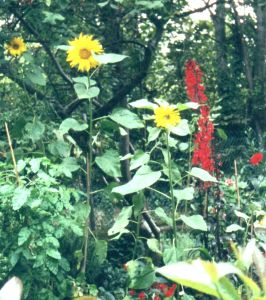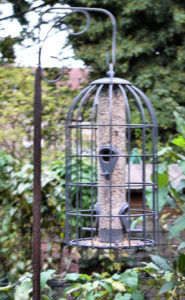COMMON SUNFLOWER (Helianthus annuus)
The Americas
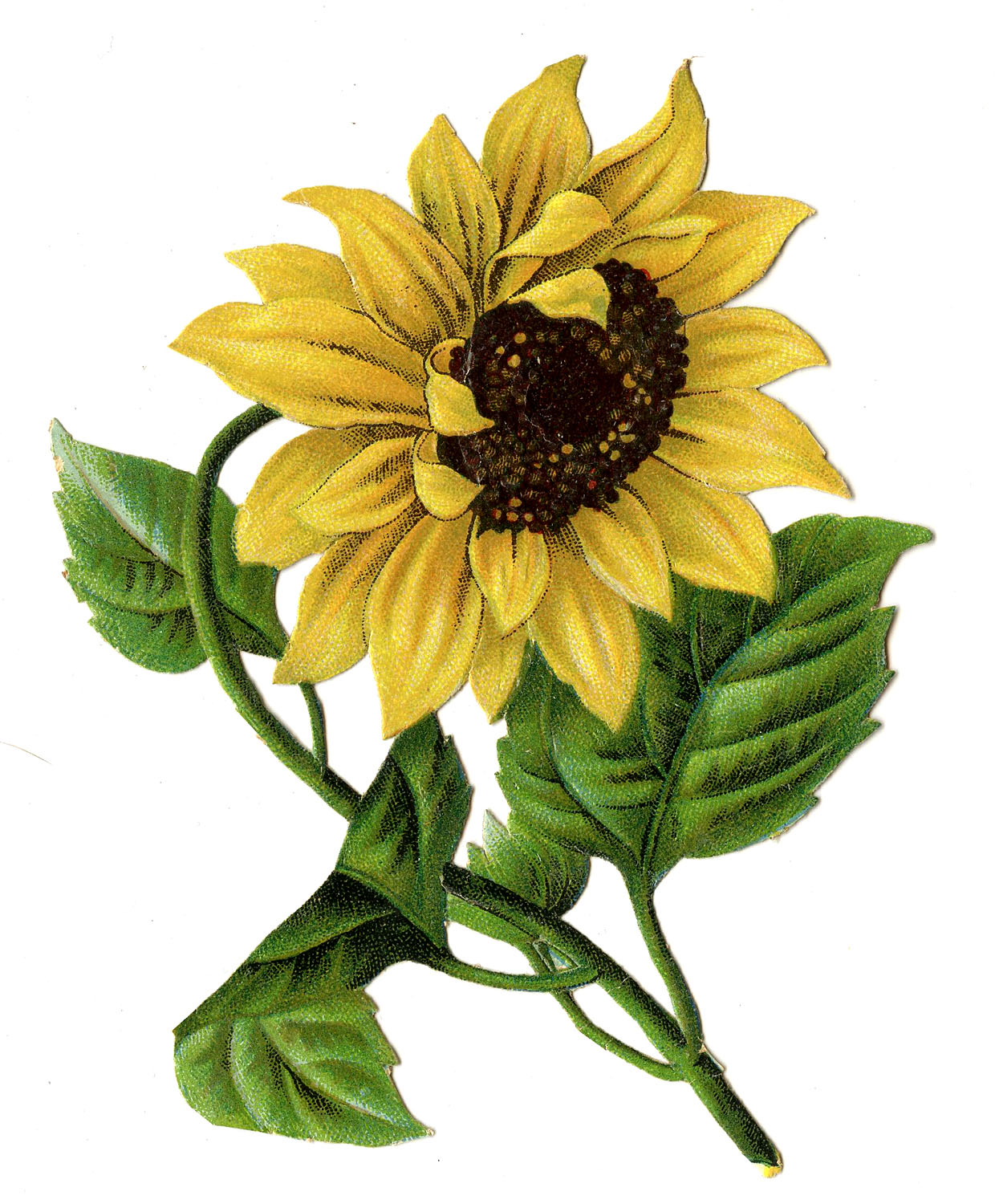
thegraphicsfairy.com
The Sunflower gets its name from the sun – helios is Greek for Sun, & anthos for flower.
Leaves of this annual are stiff, & its tall fibrous stem may reach over 3 metres. The large flowerhead is a central disc from which its petals radiate. Tiny flowers spiralling round the disc are visited by bees; after pollination each flower becomes a seed which is rich in oil & pecked up by the birds.
Sunflowers follow the sun (heliotropism). A young sunflower will face the sun when it rises in the east. As the sun travels across the sky through the day, the flower turns to follow it. When the sun sets in the west, it leaves the flower facing west. Overnight, it turns back to the east. Older flowers lose this ability to turn.
Sunflower seeds are rich in Vitamins B & E. The colours of Sunflower cultivars range from YELLOW through ORANGE to REDS & RED-PURPLES.
Records for sunflowers have included the tallest (25 ft (750 cm) tall, grown in the Netherlands) the largest sunflower head (32 1/2 in (80 cm) across, grown in Canada) & the shortest (just over 2 in (50mm) tall, grown in Oregon using the Bonsai technique.
http://www.mrsgreenfingers.co.uk/how-to-grow-sunflowers.html
Bees’ Favourite.
“Growing sunflowers for bees, birds and other wildlife: The brightly coloured petals shout “Oi! Over here!” to bees and other pollinators like hoverflies, directing them to the central spirals of the sunflower. These are formed of many hundreds of small tubular flowers, packed with nectar and pollen. The insects get covered in pollen as they feed. Pollination by wild bumblebees and bee species with longer tongues especially helps the plant produce more quality seed.” Paul de Zylva, Senior Campaigner on Nature at Friends of the Earth
Join the Generation that Saves Our Bees
What we choose to grow in our gardens can make a difference to the lives of our UK bees. For tips on how to grow sunflowers, go to Friends of the Earth’s website. It mentions two sunflowers that are deemed RHS Perfect for Pollinators – Helianthus annuus (Common sunflower) & Helianthus debilis (Cucumber leaf sunflower). FOE’s Bee Cause Campaign has 28 great plants for bees – “as well as flowers, think of herbs, fruit, vegetables, shrubs & trees – they can all provide nectar when they are in flower.”
https://www.foe.co.uk/living/articles/growing-sunflowers-bees-birds-other-wildlife
HISTORY, USES
“The leaves are used for fodder; the flower for its yellow dye. The seeds are eaten as a food, and yield an oil… which reduces the cholesterol level of the blood. The Indians used the oil as a hair grease, and warm, as a rub for rheumatic parts. The baked roots were also used, as a poultice, in rheumatism and arthritis, bruises and contusions. The entire plant was holy to the sunworshippers of Peru & was used in religious ceremonies.”
Jeanne Rose’s Herbal, HERBS & THINGS, Grosset & Dunlap, Workman Publishing Company, New York 1972.
Native Americans and the Sunflower
” The American Indian first domesticated the sunflower into a single headed plant with a variety of seed colors including black, white, red, & black/white striped. Evidence suggests that the plant was cultivated by American Indians in present-day Arizona & New Mexico about 3000 BC.
“Sunflower was used in many ways throughout the various American Indian tribes. Seed was ground or pounded into flour for cakes, mush or bread. Some tribes mixed the meal with other vegetables such as beans, squash, & corn. The seed was also cracked & eaten for a snack. There are references of squeezing the oil from the seed & using the oil in making bread.”
Non-food uses include purple dye for textiles, body painting & other decorations. The oil of the seed was used on skin & hair. The dried stalk was used as a building material. “
Some Native American tribes used the sunflower as a source of yellow and orange dye for fabric. It was known medicinally for its antimalarial properties. Sunflowers were seen as symbolic of courage by some native peoples, & warriors carried sunflower cakes with them into battle.
The sunflower originated in South & Central America & migrated north, most likely due to the migration of Spanish conquistadors. Remains of sunflowers dating back 4,600 years have been found in Mexico. In the 1500s, Spanish explorers took sunflowers back to Europe with them, & the species has spread around the world since then.
http://www.native-languages.org/legends-sunflower.htm
Sunflowers Travel the World
” Taken to Europe by Spanish explorers some time around 1500, the plant became widespread throughout present-day Western Europe – mainly as an ornamental, but some medicinal uses were developed. By 1716, an English patent was granted for squeezing oil from sunflower seed.
Sunflower became very popular as a cultivated plant in Russia in the 18th century. Most of the credit is given to Peter the Great. Initially used as an ornamental, by 1769 cultivated sunflower oil production is mentioned in the literature. By 1830, the manufacture of sunflower oil was done on a commercial scale. “
The National Sunflower Association (USA)
https://www.sunflowernsa.com/all-about/history/
Sunflowers in our Highbury Garden
We have found sunflower seeds to be the favourite food for sparrows & other small birds. Blue Tits & Great Tits will take one sunflower seed from the feeder & fly up to sit on a tree branch… they hold the sunflower against the branch with one foot, breaking it into smaller more beakable pieces.
We buy ready-shelled seed = no shells left under the feeders – as well as black sunflower seeds in their shells. Black sunflower seeds have more oil than striped seeds. In any loose scattering of seed on the ground, birds will pick out the black shelled seeds first.
—————————————————————————————————————————————-
Squirrels Like Sunflowers
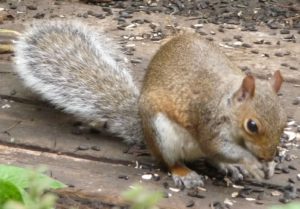 Monika, who lived here before I moved in, persuaded RF to try growing sunflowers. They would be a visual treat, & birds could eat the seeds. RF did his best, planting seeds year after year. Sunflowers grew, on stalks that were 6ft or taller – but the plants were always brought down by squirrels just as the seed ripened. Captured flowerheads were dragged to the top of the brick wall, where all seeds were devoured.
Monika, who lived here before I moved in, persuaded RF to try growing sunflowers. They would be a visual treat, & birds could eat the seeds. RF did his best, planting seeds year after year. Sunflowers grew, on stalks that were 6ft or taller – but the plants were always brought down by squirrels just as the seed ripened. Captured flowerheads were dragged to the top of the brick wall, where all seeds were devoured.
If you want to grow sunflowers & there is a strong squirrel population in your area, you may need to adopt a cunning plan to outwit them.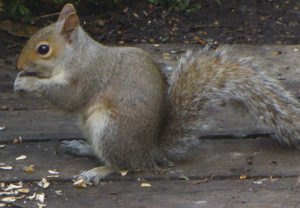
Sunflowers have gone from North America to Europe to Russia, from there to the USA & Canada, then back to Europe… Here, for our garden, we currently get sunflower seeds by mail order in large sacks from Little Peckers in Hertfordshire who import their sunflower seed from Bulgaria. And organize the delivery of a very large box of seed to our front door, by courier.
Little Peckers Unit 1, The 10 Centre, Hearle Way, Hatfield, Herts AL10 9EWUK phone o8ooo 933221
